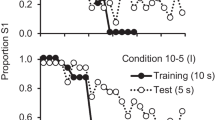Abstract
Nine subjects with mental retardation were trained with a fading procedure to perform two-choice simple-discrimination tasks. Immediately after meeting a learning criterion, discrimination reversals were trained within the same sessions, also with the fading procedure. Two 10- or 16-reversal conditions were compared within subjects: High, in which all correct responses for the initial discrimination were followed by reinforcers, and Low, in which the initial discrimination was trained with an intermittent reinforcement schedule and a lower obtained reinforcer rate. In both conditions, reinforcers followed all correct responses during reversal training. Reversal learning error rates were higher in the High condition for 8 subjects. Thus, the rate of reinforcement during the initial discrimination training was related to the persistence of stimulus control, as shown by more selections of the initially positive stimulus during reversal training in the High condition. The results are consistent with behavioral momentum theory. The results indicate that (a) behavioral momentum may describe stimulus control in discrete-trial procedures, and (b) teaching procedures may sometimes benefit from tactical reductions in local reinforcement density to encourage changes or transfers of stimulus control.
Similar content being viewed by others
References
BARROS, R. S., GALVAO, O. F., & MCILVANE, W. J. (2002). Generalized identity matching-to-sample in Cebus Apella. The Psychological Record, 52, 441–460
CARR, D., WILKINSON, K. M., BLACKMAN, D., & MCILVANE, W. J. (2000). Equivalence classes in individuals with minimal verbal repertoires. Journal of the Experimental Analysis of Behavior, 74, 101–114.
DEVANY, J. M., HAYES, S. C., & NELSON, R. O. (1986). Equivalence class formation in language-able and language-disabled children. Journal of the Experimental Analysis of Behavior, 46, 243–257.
DUBE, W. V., MCILVANE, W. J., & GREEN, G. (1992). An analysis of generalized identity matching-to-sample test procedures. The Psychological Record, 42, 17–28.
DUBE, W. V. & SERNA, R. W. (1998). Reevaluation of a programmed method to teach generalized identity matching to sample. Research in Developmental Disabilities, 19, 347–379.
LERMAN, D. C., & IWATA, B. A. (1996). Developing a technology for the use of operant extinction in clinical settings: An examination of basic and applied research. Journal of Applied Behavior Analysis, 29, 345–382.
MACKINTOSH, N. J. (1974). The psychology of animal learning. New York: Academic Press.
MCILVANE, W. J., & DUBE, W. V. (2000). Behavioral momentum and multiple stimulus control topographies [commentary]. Behavioral and Brain Sciences 23 109.
MCILVANE, W.J., KLEDARAS, J. B., IENNACO, F. M., MCDONALD, S. J., & STODDARD, L. T. (1995). Some possible limits on errorless discrimination reversals in individuals with severe mental retardation. American Journal on Mental Retardation, 99, 430–436.
NEVIN, J. A. (1992). An integrative model for the study of behavioral momentum. Journal of the Experimental Analysis of Behavior, 57, 301–316.
NEVIN, J. A., & GRACE, R. C. (2000). Behavioral momentum and the Law of Effect. Behavioral and Brain Sciences, 23, 73–130.
NEVIN, J. A., GRACE, R. C., HOLLAND, S., & MCLEAN, A. P. (2001). Variable-ratio versus variable-interval schedules: Response rate, resistance to change, and preference. Journal of the Experimental Analysis of Behavior, 76, 43–74.
NEVIN, J. A., TOTA, M. E., TORQUATO, R. D., & SHULL, R. L. (1990). Alternative reinforcement increases resistance to change: Pavlovian or operant contingencies? Journal of the Experimental Analysis of Behavior, 53, 359–379.
SAUNDERS, K. J., JOHNSTON, M. D., TOMPKINS, B. F., DUTCHER, D. L., & WILLIAMS, D.C. (1997). Generalized identity matching of two-dimensional forms by individuals with moderate to profound mental retardation. American Journal on Mental Retardation, 102, 285–291.
SAUNDERS, K. J., & SPRADLIN, J. E. (1989). Conditional discrimination in mentally retarded adults: The effects of training the component simple discriminations. Journal of the Experimental Analysis of Behavior, 52, 1–12.
SAUNDERS, K. J., & SPRADLIN, J. E. (1990). Conditional discrimination in mentally retarded adults: The development of generalized skills. Journal of the Experimental Analysis of Behavior, 54, 239–250.
SIDMAN, M., & STODDARD, L. T. (1967). The effectiveness of fading in programming a simultaneous form discrimination for retarded children. Journal of the Experimental Analysis of Behavior, 10, 3–15.
Author information
Authors and Affiliations
Corresponding author
Additional information
This research was supported by NICHD Grant HD 33802. The contents of this paper are solely the responsibility of the authors and do not necessarily represent the official views of NICHD. Portions of the data were presented in a poster at the May 2001 meeting of the Society for the Quantitative Analysis of Behavior. We thank Lyn Balsamo, Kristin Lombard, and Jason Krienke for help with implementation, data collection, and data analysis; and also Jen Brooks, Kathy Clark, Kevin Farren, Paul Filkins, Tom Fowler, Fay lennaco, Susan Kelledy, Alison McVay, Nora Murphy, Rena Sphritzer, Aimee Smith, Susan Stanford, and Sharon Wang for their help with data collection. Special thanks to Elenice Hanna for comments on the manuscript, and The New England Center for Children and The Protestant Guild Learning Center for their cooperation.
Rights and permissions
About this article
Cite this article
Dube, W.V., McIlvane, W.J. Reinforcer Rate and Stimulus Control in Discrimination Reversal Learning. Psychol Rec 52, 405–416 (2002). https://doi.org/10.1007/BF03395194
Published:
Issue Date:
DOI: https://doi.org/10.1007/BF03395194




